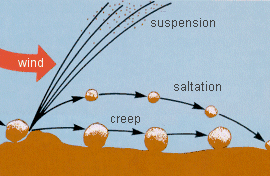Traction (geology)
Traction is the geologic process whereby a current transports larger, heavier rocks by rolling or sliding them along the bottom. Thus, the grains and clasts interact with the substratum during transport. By contrast, saltation, a related sediment transport process, moves grains across the bottom by bouncing or hopping. The actual current carries the sediment load in traction and saltation flows, whereas downslope movement under the force of gravity carries the sediment in gravity flows. These processes contrast with suspension settling, in which there is no current.[1][2] Traction is where large stones or boulders in the river's load are rolled along by the force of the river.

Notes and references
- Helm, Janet and Robinson, Arthur (2002), GCSE Geography for AQA Specification, Heinemann, p. 6.
- Ritter, M.E. (2006), The Physical Environment: an Introduction to Physical Geography: The Geologic Work of Streams Archived 2013-05-15 at the Wayback Machine, online textbook. accessed 25 June 2013.
gollark: No idea, don't follow American history.
gollark: Dell doesn't have to take that on directly but Apple certainly does.
gollark: What? They sell computers. Semiconductor stuff is literally *the* most capital-intensive industry.
gollark: In a working electoral system you would vote for more representative people, not arbitrarily rule out some classes of people based on some requirements.
gollark: If your "physical requirements" are physical fitness ones then that seems like a different argument.
This article is issued from Wikipedia. The text is licensed under Creative Commons - Attribution - Sharealike. Additional terms may apply for the media files.